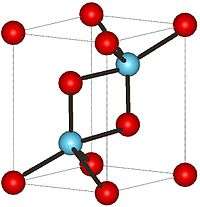Cerium(III) oxide
 | |
| Names | |
|---|---|
| IUPAC name
Cerium(III) oxide | |
| Other names
Cerium sesquioxide | |
| Identifiers | |
| 1345-13-7 | |
| ECHA InfoCard | 100.014.289 |
| Properties | |
| Ce2O3 | |
| Molar mass | 328.24 g/mol |
| Appearance | yellow-green dust |
| Density | 6.2 g/cm3 |
| Melting point | 2,177 °C (3,951 °F; 2,450 K) |
| Boiling point | 3,730 °C (6,750 °F; 4,000 K) |
| insoluble | |
| Solubility in sulfuric acid | soluble |
| Solubility in hydrochloric acid | insoluble |
| Structure | |
| Hexagonal, hP5 | |
| P-3m1, No. 164 | |
| Related compounds | |
| Other anions |
Cerium(III) chloride |
| Other cations |
Lanthanum oxide, Praseodymium(III) oxide |
| Related compounds |
CeO2 |
| Except where otherwise noted, data are given for materials in their standard state (at 25 °C [77 °F], 100 kPa). | |
| | |
| Infobox references | |
Cerium(III) oxide, also known as cerium oxide, cerium trioxide, cerium sesquioxide, cerous oxide or dicerium trioxide, is an oxide of the rare earth metal cerium. It has chemical formula Ce2O3, and is gold-yellow in color.
Applications
Engine and exhaust catalysts
Cerium oxide is used as a catalytic converter for the minimisation of CO emissions in the exhaust gases from motor vehicles.
When there is a shortage of oxygen, cerium(IV) oxide is reduced by carbon monoxide to cerium(III) oxide:
- 2 CeO
2 + CO → Ce
2O
3 + CO
2
When there is an oxygen surplus, the process is reversed and cerium(III) oxide is oxidized to cerium(IV) oxide:
- 2 Ce
2O
3 + O
2 → 4 CeO
2
Major automotive applications for cerium(III) oxide are, as a catalytic converter for the oxidation of CO and NOx emissions in the exhaust gases from motor vehicles,[1][2] and secondly, cerium oxide finds use as a fuel additive to diesel fuels, which results in increased fuel efficiency and decreased hydrocarbon derived particulate matter emissions,[3] however the health effects of the cerium oxide bearing engine exhaust is a point of study and dispute.[4][5][6]
Water splitting
The cerium(IV) oxide–cerium(III) oxide cycle or CeO2/Ce2O3 cycle is a two step thermochemical water splitting process based on cerium(IV) oxide and cerium(III) oxide for hydrogen production.[7]
Illumination
Cerium(III) oxide combined with tin(II) oxide (SnO) in ceramic form is used for illumination with UV light. It absorbs light with a wavelength of 320 nm and emits light with a wavelength of 412 nm.[8] This combination of cerium(III) oxide and tin(II) oxide is rare, and obtained only with difficulty on a laboratory scale.
Production
Cerium(III) oxide is produced by the reduction of cerium(IV) oxide with hydrogen at approximately 1,400 °C (2,550 °F) to make air stable cerium(III) oxide.
References
- ↑ Bleiwas, D.I. (2013). Potential for Recovery of Cerium Contained in Automotive Catalytic Converters. Reston, Va.: U.S. Department of the Interior, U.S. Geological Survey.
- ↑ "Argonne's deNOx Catalyst Begins Extensive Diesel Engine Exhaust Testing".
- ↑ "Exploring Nano-sized Fuel Additives EPA scientists examine nanoparticle impacts on vehicle emissions and air pollution.".
- ↑ "Nanoparticles used as additives in diesel fuels can travel from lungs to liver, November 18, 2011. Marshall University Research Corporation".
- ↑ "Inhal Toxicol. 2008 Apr;20(6):547-66. doi: 10.1080/08958370801915309 . Hazard and risk assessment of a nanoparticulate cerium oxide-based diesel fuel additive - a case study.".
- ↑ "Exploring Nano-sized Fuel Additives EPA scientists examine nanoparticle impacts on vehicle emissions and air pollution.".
- ↑ Hydrogen production from solar thermochemical water splitting cycles Archived August 30, 2009, at the Wayback Machine.
- ↑ Spectral Studies of New Luminophors for Dental Porcelain